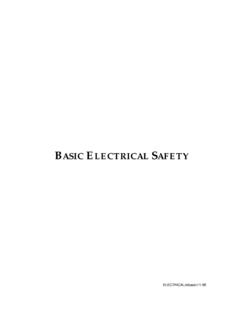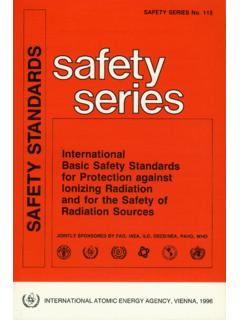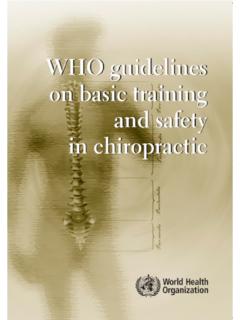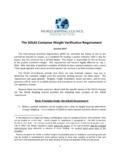Transcription of Basic Electrical Safety
1 Electrical /elbasic1/1-95 Basic Electrical SAFETYPREFACEThe concepts discussed herein are intended to provide explanationand clarification of Basic Electrical Safety for individuals who havelittle or limited training or familiarity with the field of understanding of these principles is essential for comprehensionof OSHA's Electrical Safety OF CONTENTSTOPICPAGET heory of of of Electricity on the Human Workplace Protective Fault Circuit Department of LaborOSHA Office of Training and EducationELECTRICAL/elbasic1/1-951 THEORY OF ELECTRICITYWhat is Electricity?Though you cannot see electricity, you are aware of it every day. You see it used in countlessways. You cannot taste or smell electricity, but you can feel , there are two kinds of electricity - static (stationary) and dynamic (moving).
2 Thismodule is about dynamic electricity because that is the kind commonly put to (dynamic) is characterized by the flow of electrons through a conductor. To understandthis phenomenon, you must know something about chemical elements and and AtomsElements are the most Basic of materials. Every known substance - solid, liquid, or gas - iscomposed of atom is the smallest particle of an element that retains all the properties of that element has its own kind of atom; , all hydrogen atoms are alike, and they are alldifferent from the atoms of other elements. However, all atoms have certain things incommon. They all have an inner part, the nucleus, composed of tiny particles called protonsand neutrons.
3 An atom also has an outer part. It consists of other tiny particles, calledelectrons, which orbit around the nucleus. Neutrons have no Electrical charge, but protonsare positively charged. Electrons have a negative charge. The atoms of each element have adefinite number of electrons, and they have the same number of protons. An aluminumatom, for example, has thirteen of each. The opposite charges - negative electrons andpositive protons - attract each other and tend to hold electrons in orbit. As long as thisarrangement is not changed, an atom is electrically balanced. This is illustrated in the Department of LaborOSHA Office of Training and EducationELECTRICAL/elbasic1/1-952 However, the electrons of some atoms are easily moved out of their orbits.
4 This ability ofelectrons to move or flow is the basis of current electrons leave their orbits, they are referred to as free electrons. If the movement offree electrons is channeled in a given direction, a flow of electrons occurs. As previouslystated, the flow of electrons through a conductor characterizes dynamic Department of LaborOSHA Office of Training and EducationELECTRICAL/elbasic1/1-953 Electrical MaterialsA material that contains many free electrons and is capable of carrying an electric current iscalled a conductor. Metals and (generally) water are conductors. Gold, silver, aluminum andcopper are all good that contain relatively few free electrons are called insulators. Non-metallic materialssuch as wood, rubber, glass and mica are conductors include the human body, earth, and ElectricityThere are several ways to produce electricity.
5 Friction, pressure, heat, light, chemical action,and magnetism are among the more practical methods used to make electrons move along date, magnetism is the most inexpensive way of producing Electrical power and is thereforeof most interest to us. Because of the interaction of electricity and magnetism, electricity canbe generated economically and abundantly and electric motors can be used to drive is produced when a magnet is moved past a piece of wire. Or, a piece of wire canbe moved through a magnetic field. A magnetic field, motion, and a piece of wire are neededto produce , Current and ResistanceVoltageA force or pressure must be present before water will flow through a pipeline. Similarly,electrons flow through a conductor because a force called electromotive force (EMF) isexerted.
6 The unit of measure for EMF is the volt. The symbol for voltage is the letter E. Avoltmeter is used to measure Department of LaborOSHA Office of Training and EducationELECTRICAL/elbasic1/1-954 CurrentFor electrons to move in a particular direction, it is necessary for a potential difference to existbetween two points of the EMF source. The continuous movement of electrons past a givenpoint is known as current. It is measured in amperes. The symbol for current is the letter Iand for amperes, the letter A. It is sometimes necessary to use smaller units of milliampere (mA) is used to indicate 1/1000 ( ) of an ampere. If an even smaller unitis needed, it is usually the microampere ( A). The microampere is one-millionth of ammeter is used to measure current in amperes.
7 A microammeter or a milliammeter maybe used to measure smaller units of movement of electrons along a conductor meets with someopposition. This opposition is known as resistance. Resistance canbe useful in Electrical work. Resistance makes it possible to generateheat, control current flow, and supply the correct voltage to a device. The symbol forresistance is shown in the accompanying general, resistance in a conductor depends on four factors: the material from which it ismade, the length, the cross-sectional area, and the temperature of the material.! materials have different resistances. Some, such as silver andcopper, have a low resistance, while others, such as iron have a higher resistance.
8 ! a given material that has a constant cross-sectional area, the total resistanceis proportional to the length. The longer the conductor, the greater the resistance.!Cross-Sectional varies inversely with the cross-sectional area of theconductor. In other words, the resistance decreases as the cross-sectional area increases.! , in metals, the resistance increases as the temperature non-metals, the reverse is usually Department of LaborOSHA Office of Training and EducationELECTRICAL/elbasic1/1-955 The symbol for resistance is the letter R. Resistance is measured by a unit called the Greek letter omega (S) is used as the symbol for Electrical figure below summarizes the factors that affect Department of LaborOSHA Office of Training and EducationELECTRICAL/elbasic1 Department of LaborOSHA Office of Training and EducationELECTRICAL/elbasic1/1-957 Direct Current (dc) CircuitsIntroductionThis section discusses the Electrical relationships in direct-current circuits.
9 Althoughalternating current is more commonly used in Electrical work, direct current has its own uniqueapplications and advantages. Direct current always flows in one dc motors, for example, have speed control characteristics that are better in someproduction operations. Direct current is used to charge storage batteries, for platingoperations, for aluminum refining, and to operate electromagnetic lifting devices and mostwelding CircuitA complete circuit is necessary for the controlled flow or movement of electrons along aconductor. A complete circuit is made up of a source of electricity ( , battery), a conductor,and a consuming device (load). This is illustrated in the figure Department of LaborOSHA Office of Training and EducationELECTRICAL/elbasic1/1-958 The orientation of the positive (+) and negative (-) terminals of the battery remains this voltage polarity does not change, the electrons flow in one direction.
10 The negativelycharged electrons flow away from the (-) terminal of the voltage source and toward the (+)terminal of the voltage source. By convention, the direction of current flow is the directionin which positive electricity would move to cause the same effects as are produced by theactual motion of electricity. Therefore, the direction of current, as it is usually considered, isin the opposite direction to the motion of the movement of the electrons along the completed path provides energy. If the circuit isso arranged that the electrons have only one path, the circuit is called a series circuit. If thereare two or more paths for electrons, the circuit is called a parallel CircuitThe figure below shows three loads (resistors) connected in series.









